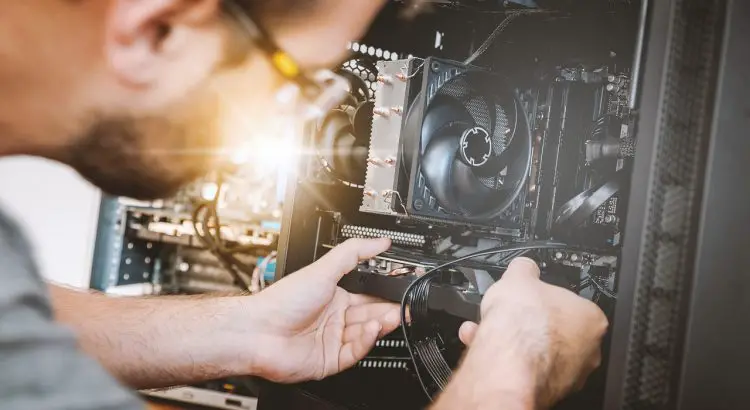V. Reseat and Inspect Other Components
I. Initial Inspection
That’s correct! The initial inspection is crucial in troubleshooting the VGA light issue on a motherboard. By powering off, unplugging the computer, and visually inspecting for physical damage or loose connections, you can often identify obvious problems that may be causing the VGA light issue. This simple step can help you pinpoint and potentially resolve the issue without needing more complex troubleshooting.
II. Basic Checks
That’s correct! In the “Basic Checks” section, re-seating the GPU firmly and verifying the power connections to the GPU are crucial steps for addressing the VGA light issue on a motherboard. These actions can often resolve problems related to loose connections or poor contact with the graphics card, which might be the cause of the issue.
III. Software Troubleshooting
You’ve got it! In the “Software Troubleshooting” section, booting into Safe Mode, updating graphics drivers, and checking the BIOS/UEFI settings are all important steps to investigate and potentially resolve the VGA light issue on a motherboard. These actions address potential software or configuration-related problems that could be causing the issue.
IV. Hardware Testing
Great! In the “Hardware Testing” section, testing the GPU in another computer, trying integrated graphics (if available), and testing with a spare GPU are key steps for diagnosing and addressing hardware-related issues that might trigger the motherboard’s VGA light. These steps help determine whether the problem lies with the graphics card or other components.
V. Reseat and Inspect Other Components
You’ve got it! In the “Reseat and Inspect Other Components” section, re-seating the RAM and CPU and checking the power supply are important steps to ensure that other crucial components are properly connected and functioning correctly. These actions can help rule out issues with these components contributing to the VGA light problem.
VI. Monitor and Cables
Absolutely! In the “Monitor and Cables” section, testing the monitor with another device and ensuring secure, undamaged video cables are vital steps to eliminate potential issues from the display or the cables themselves. These checks help confirm that the VGA light issue is not caused by problems with the monitor or its connections.
VII. Consult the Motherboard Manual
Correct! Consulting the motherboard manual is a smart move in the troubleshooting process. The manual often provides detailed information about what the VGA light specifically indicates and can offer valuable insights into the nature of the problem. This step can help you better understand and address the issue.
VIII. Seek Professional Help
Indeed, seeking professional help is the last step in the troubleshooting process. If the VGA light issue on the motherboard persists despite your efforts, consulting a qualified technician or contacting the manufacturer’s support is a wise decision. They can provide expert assistance and guidance to effectively diagnose and resolve the problem.
FAQ.
Q1: What does it mean when the VGA light on my motherboard is on?
A1: The VGA light typically indicates a problem with the graphics card or the display output. It could be due to loose connections, faulty graphics cards, driver issues, or other hardware-related problems.
Q2: Why is it important to power off and unplug the computer during the initial inspection?
A2: Powering off and unplugging the computer is essential for safety to avoid electrical shocks and prevent any damage to components when inspecting or working on the motherboard.
Q3: How do I re-seat the GPU?
A3: To re-seat the GPU, first power off and unplug the computer. Then, gently remove the graphics card from its slot and carefully re-insert it into the same slot, ensuring it’s firmly and securely seated.
Q4: What should I do if updating graphics drivers doesn’t solve the VGA light issue?
A4: If updating drivers doesn’t resolve the issue, consider testing the graphics card in another computer or trying a spare GPU. If the issue persists, it might be a hardware problem with the graphics card.
Q5: Can the VGA light issue be caused by issues with the monitor or video cables?
A5: Yes, problems with the monitor or video cables can sometimes trigger the VGA light issue. Testing the monitor with another device and ensuring secure, undamaged video cables are important steps to rule out these possibilities.
Q6: What if I can’t find the motherboard manual?
A6: If you can’t locate the motherboard manual, you can often find it online on the manufacturer’s website. Alternatively, you can contact the motherboard manufacturer’s customer support for assistance.
Q7: How can I tell if the VGA light issue is a hardware or software problem?
A7: Testing the GPU in another computer, trying integrated graphics, or using a spare GPU can help determine if the issue is hardware-related. Software troubleshooting, like updating drivers and checking BIOS settings, can help identify software-related issues.
Q8: Is it safe to perform these troubleshooting steps if I’m not experienced with computer hardware?
A8: While the outlined steps are generally safe, handling computer hardware requires care. If you’re not comfortable or experienced, it’s advisable to seek assistance from a knowledgeable technician to avoid potential damage to components.
Q9: What should I do if all troubleshooting steps fail to resolve the VGA light issue?
A9: If you’ve exhausted all troubleshooting steps and the problem persists, it’s best to consult a professional technician or contact the motherboard/graphics card manufacturer’s support for further assistance.
Q10: How can I prevent the VGA light issue from occurring in the future?
A10: To prevent the VGA light issue, regularly maintain your computer by keeping it clean from dust, ensuring proper ventilation, and updating drivers and firmware. Also, handle hardware components carefully and avoid overclocking if you’re not experienced with it.
